Spend Less Time Cutting the Grass With These Expert-Recommended Riding Lawn Mowers
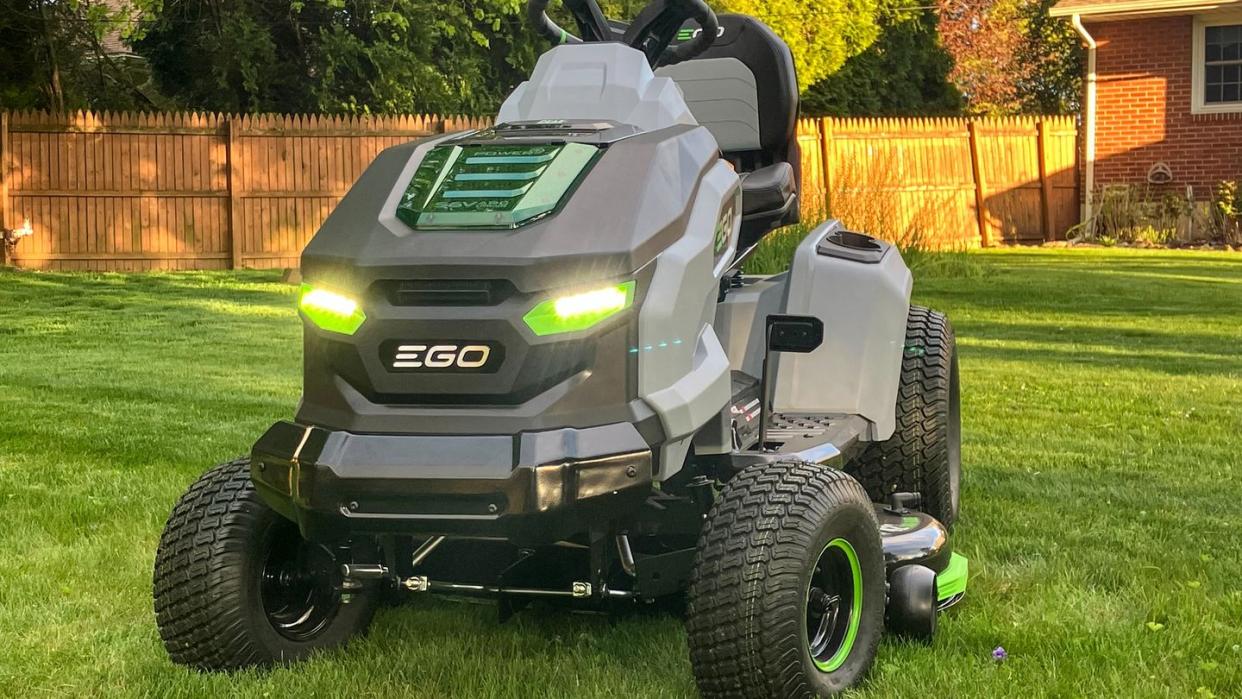
"Hearst Magazines and Yahoo may earn commission or revenue on some items through these links."
If your property has a yard that spans more than half an acre, then you know a standard walk-behind lawn mower simply isn’t big enough to efficiently keep your lawn mowed all spring and summer. Unless you want to spend a few hours every week mowing your acre-sized lawn, investing in a riding lawn mower could cut your grass-trimming time significantly.
Riding lawn mowers vary quite a bit from model to model. There are small rear-engine mowers for yards up to 1 acre, and lawn tractors and zero-turn lawn mowers that will make quick work of larger jobs.
Any model, regardless of your needs, is going to be a relatively expensive piece of machinery. You don’t want to rush into a purchase without figuring out what you need. Luckily, we’ve put in our fair share of miles on these large yard machines and can help you find the best riding mower for your lawn.
Best Riding Lawn Mowers
Best Overall: Cub Cadet Enduro LT46
Best Value: Troy-Bilt 30 in. 10.5 HP Riding Mower
Tightest Turn Radius Tractor: Craftsman T2200 Hydrostatic Turntight Riding Lawn Mower
Best Battery Powered Tractor: EGO Power+ T6
Best Gas Zero-Turn: Toro 42-inch TimeCutter
[table-of-contents] stripped
What to Consider When Picking a Riding Lawn Mower
Types of Riding Lawn Mowers
There are three types of riding lawn mowers to choose from–rear engine|rear motor, tractor, and zero-turn. Picking the right one for you largely depends on the size of your green space and your budget, but there are important technical distinctions among them and it pays to know one from another.
Lawn Tractors
Lawn tractors have an engine or battery array mounted on the front of the mower, with a driver’s seat and steering wheel behind the hood, like you’d see on a larger agricultural tractor. With wide mowing decks typically ranging from 42 to 54 inches, they can tackle lawns that are several acres large.
In addition to cutting grass, the tractor design is also great for towing yard equipment, such as a large fertilizer spreader, lawn aerator, or pull cart.
Lawn tractors are ideal for cutting large lawns and towing yard equipment, but they have a relatively wide turning radius compared to other mower types and can be cumbersome if you have an area that requires lots of tight turns. Additionally, the engine placement can limit your visibility from the driver’s seat. If you have a lot of trees, gardens, and landscaping beds, you may want to go with a rear-engine or zero-turn model.
Rear Engine | Rear Motor Mowers
Rear engine | Rear Motor mowers are the smallest type of riding lawn mower. Compared to other types, they’re shorter and narrower, making them more maneuverable than their larger counterparts, and they typically have a cutting width of about 30 inches. Since the engine or motor sits behind the driver’s seat, there’s little to block your view besides the steering wheel as you’re mowing, making them easy to navigate around landscaping beds and trees.
Due to their relatively narrow cutting width, they’re a good fit for yards up to 1 acre in size. Since they’re smaller, rear engine mowers also tend to be the least expensive of the three core designs, so they’re ideal for budget-conscious buyers.
Zero-Turn Mowers
Zero-turn mowers combine large mowing decks with unparalleled maneuverability. Instead of driving with a steering wheel, you control it with a pair of lap bars— one for the left drive wheel and one for the right— that allows you to turn the mower on a dime. Since there’s nothing high sitting in front of the driver’s seat, you get a wide open view as you’re mowing.
Zero-turn mowers are large and quick. They move faster than lawn tractors, and residential versions have similar-sized decks to tractors—42 inches to 54 inches and beyond—making them ideal for mowing large yards.
The downside, unsurprisingly, is the price tag. Even the most affordable zero-turn mowers cost several thousand dollars. Also, due to their weight distribution with the engine on the back and nothing up front, they aren’t as ideal for towing yard implements as tractors are.
Deck Width
The mowing blades of any riding lawn mower are housed in a steel cutting deck, which sits just above the ground you are moving over. The width of the deck determines how wide a swath of grass the mower cuts with each pass.
Ideally, you want to look for a riding mower that allows you to cut your grass in about an hour to an hour and half. A deck width of around 30 inches will allow you to cover about an acre in that time. Move up to a larger mower with a 42-inch deck for yards up to 1.5 acres. Finally, upgrade to a deck size of 50 inches or more for any property larger than 2 acres.
Engine/Motor and Fuel Type
A riding lawn mower is a piece of heavy machinery, which means it is only as good as the engine or motor that drives it. A riding lawn mower engine powers both the blades and the drive wheels. A mower with a powerful engine or motor will cut a lawn quickly and cleanly. An underpowered one will drive slowly and require more passes to complete the job.
When looking at a riding lawn mower, pay attention to the engine’s output. An 11- to 15-horsepower engine or motor can adequately power a mower with a 30-inch deck. For mowers with decks between 42- to 46 inches, you should look for no less than 16 horsepower. For the largest mowers, with decks between 52- and 60 inches, you want an engine capable of producing 22 or more horsepower.
The market for battery-powered lawn equipment has blossomed in recent years, and that includes riding lawn mowers. There are a few brands, such as Ego, that make only battery-electric lawn equipment. Some brands, such as Craftsman, offer primarily gas-engine equipment but have expanded into the electric equipment segment.
Battery-powered mowers require less maintenance than gas-powered ones, as they don’t need oil changes and you don’t have to worry about fuel going stale and needing to clean the carburetor. They also run at lower noise levels. As with other outdoor appliances, though, battery-powered mowers can lack the raw power of traditional gas-powered riding mowers. Popular Mechanics Test Editor Roy Berendsohn has commented that gas-powered mowers are superior when it comes to fall leaf cleanup as well.
Charging time is also a potential issue. Battery-powered mowers can run for a couple of hours on a single charge, then typically need a few hours to recharge, unless you have an alternate set of fresh batteries to swap in. Obviously with gas-powered mowers, refueling takes far less time when you run out of gas.
Transmissions
Any mower on which you ride will have a transmission of some sort to take power from the engine or battery bank and transfer it to the rear wheels. In its simplest respect, you either have a mower that has an automatic transmission of some kind or a manual transmission.
Manual geared transmission
These are found only on comparatively-inexpensive lawn tractors. The transmission is a complex assembly of gears and shafts. An input shaft into the transmission is driven by a pulley and belt off the engine.
To operate a manual transmission on a riding lawn mower, you depress a foot pedal that disengages the pulley drive from the engine to the transmission. This stops the tractor’s forward motion, allowing you move a hand lever to select the gear you want. When you let off pressure on the pedal, the tractor moves forward.
By moving the tractor’s throttle forward (or up), you go faster, up to the maximum possible in the gear you have selected. To slow down, you move the throttle lever down, decreasing engine speed. To stop, you push in the foot pedal. To remain stopped, you move the transmission lever into the neutral position.
Automatic transmission
This covers a group of transmissions whereby you control forward speed simply by pressing down on a foot pedal or moving a pair lap bars forward.
– Hydrostatic transaxle: a fluid drive system operated by a lap bar (zero-turn mowers) or a foot pedal (lawn and garden tractors). Pushing the lap bar or foot pedal forward increases fluid flow through the transaxle, causing it to spin faster. An axle shaft coming off the transmission drives the wheel (or wheels) to which it is connected.
– Continuously Variable Transmission (CVT): a drive system that uses conical-shaped stepped pulleys. A belt riding up and down on the pulleys transfers rotational force to control ground speed. Used on few mid-priced lawn tractors and expensive agricultural and construction tractors, the operator increases or decreases ground speed by a foot pedal. A linkage from the pedal changes the position of the belt on the pulleys, increasing or decreasing ground speed.
– Electro-hydrostatic transmission: a hybrid transmission found on electric tractors and electric ZTR mowers that uses an electric motor to drive the transaxle.
Seating
If you have a yard or field large enough to warrant spending thousands of dollars on a riding lawn mower, chances are that you’ll spend a pretty long time mowing. If you care about your back (and your backside), you should make sure that you’ll be able to sit comfortably on your mower.
Look for a riding lawn mower with a seat that you find comfortable. It should have coil shock absorbers to cushion the ride and a high back that provides lumbar support. Some riding mowers also include such creature comforts as armrests and cup holders, which definitely come in handy if you’re tending to a larger area.
Why Trust Us
Popular Mechanics has been testing and reviewing home products and tech for over a century, and its current test team has decades of experience running various products through a battery of scrutinizing tests. Roy Berendsohn has been a senior test editor with the publication for more than 35 years, and has more than 50 years of experience operating mowers.
He’s tested everything from old-fashioned reel mowers that are entirely human powered to diesel-engine commercial mowers–and everything in between. He’s witnessed the advent of entirely new product categories, including battery powered walk-behind mowers and zero-turn mowers.
Colin Aylesworth is a Popular Mechanics Deputy Editor who, separately, happens to have several years of lawn mower repair experience. What started as simply trying to fix his own mower has blossomed into a part time size hustle of repairing mowers for others. Since joining PM, he’s had the opportunity to sample new offerings in the battery-powered realm, both walk-behind and riding mowers.
Tony Carrick is a full-time freelance writer who specializes in technology, home improvement, DIY, home security, and outdoor recreation. He’s tested and written about everything from home security systems to power tools to gas grills, as well as lawn mowers. His product guides, how-to articles, and feature stories can be found in such publications as Bob Vila, Angi, U.S. News and World Report, Field & Stream, Futurism, and Switchful.
How We Evaluated The Best Riding Lawn Mowers
For this most recent update to the Best Riding Lawn Mower article, we borrowed from the previous version written by Tony Carrick and weighed his information with the decades of testing and research from the Popular Mechanics Test Team, with specific input from Roy Berendsohn.
Some of the picks in this article have been recently tested, and other recommendations are based on prior testing experience with similar mowers from trusted brands, as well as a close analysis of each mower’s specs and knowledge of the industry in general.
Our Full Riding Mower Reviews

Enduro LT46
homedepot.com
$2499.99
The Cub Cadet XT1 has everything we look for in a lawn tractor. It’s equipped with a 46-inch deck, making it ideal for handling larger lawns–up to 2 acres would be ideal for this. However, it maintains a manageable turning radius of 16-inches, so you can navigate around trees and landscaping beds without too much difficulty.
With a 23 horsepower gasengine, it’s more than powerful enough to keep the blades spinning at high speed. The hydrostatic transmission makes speed changes easy, and a push-button cruise control system allows you to rest your right foot on longer straightaways.
The adjustable deck features 12 cutting height options, giving you the choice to how high or low to cut. It also has a deck cleanout that lets you rinse grass out of the mowing deck. To use this feature, hook up a garden hose to the port, position the deck to its lowest setting, and start the mower and blades, and let it run for a few minutes.
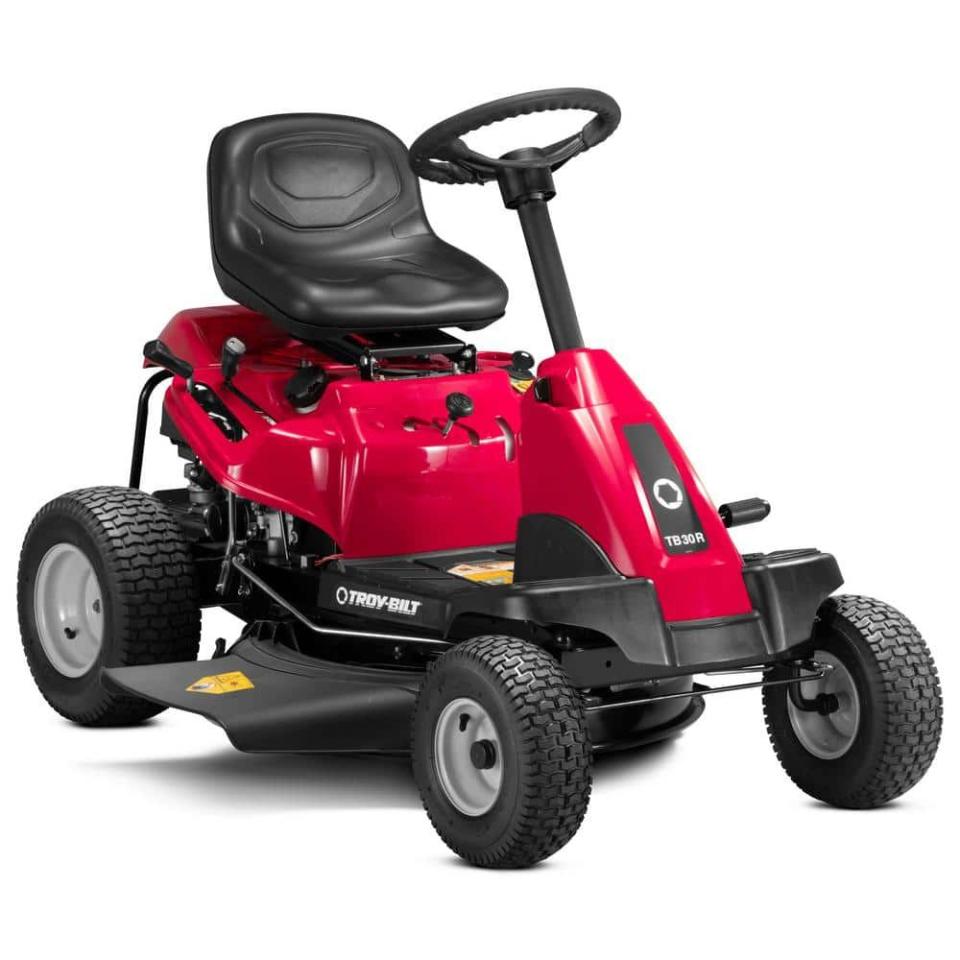
30 in. 10.5 HP Riding Mower
homedepot.com
$1939.00
If you’re looking for a relatively inexpensive riding mower to handle yards up to 1 acre, look no further than this rear-engine model from Troy-Bilt. It has a 10.5- horsepower engine and a 30-inch mowing deck that comes equipped with a mulch kit. The mower has a small turning radius of just 18 inches, making it easy to maneuver around tight spaces. It also comes equipped with larger wheels than you typically find on a rear-engine mower, ensuring you won’t get slowed down by uneven terrain, steep grades, or soft soil.
This mower has a manual transmission, but it should be fairly easy to get the hang of, and it’s part of the reason for this mower’s relatively affordable price. At just 30 inches wide and about 5 feet long, this mower is compact, making it easy to store in your garage or shed and drive through narrow fence gates.
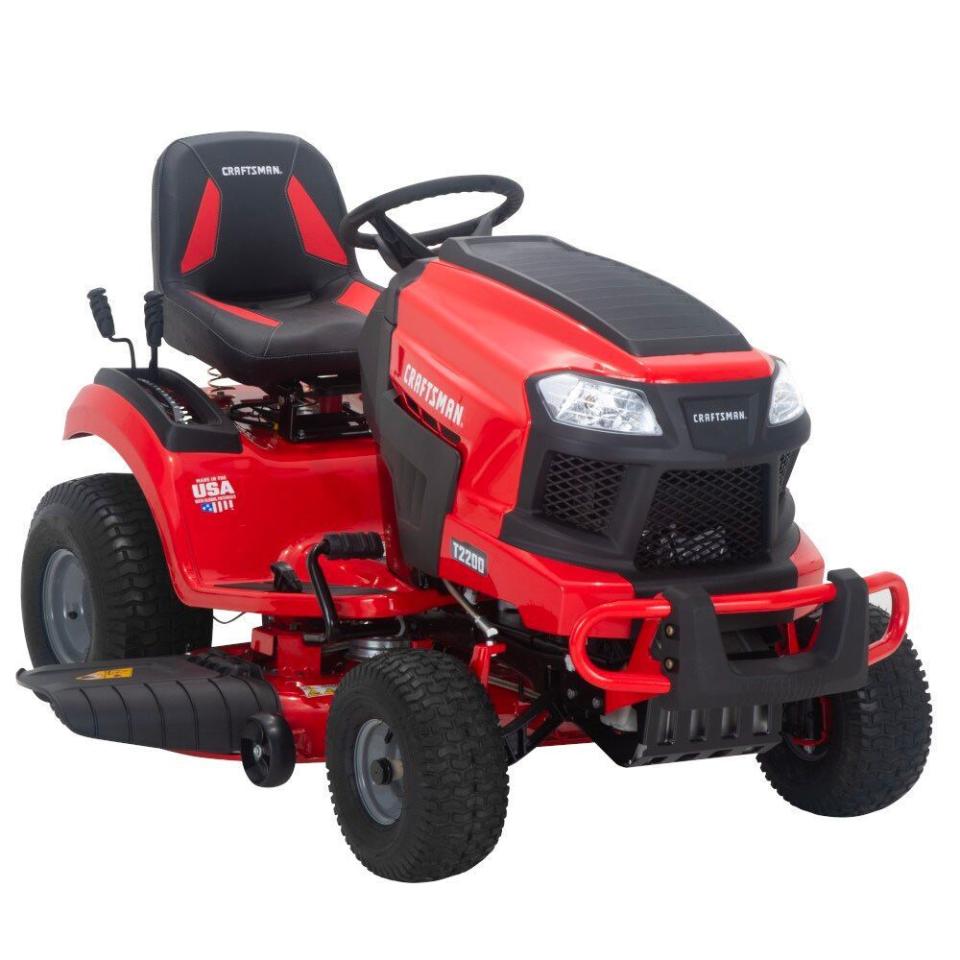
T2200K Hydrostatic Turntight Riding Lawn Mower
lowes.com
$2599.00
Craftsman’s T2200K strikes the right balance between size and maneuverability. It sports a 42-inch deck, making it ideal for yards up to 1.5 acres. This mower’s big advantage is its tight turning radius—just 5-inches, which is superb for a lawn tractor. That attribute makes this mower ideal if you prefer a tractor-style machine but have lots of tight turns to maneuver.
Under the hood, a 20-horsepower Kohler engine provides plenty of giddy-up to power both deck and drive wheels. It’s equipped with a hydrostatic transmission for smooth speed changes and gives you 12 height options for cutting grass. There’s also a brush guard that protects the front end of the tractor.
Craftsman also includes some nice extra touches, including a high-back cushioned seat and a soft-touch steering wheel. Its ability to mow large lawns in a timely manner while still being nimble enough to navigate around obstacles makes the Craftsman a great all-around lawn tractor.
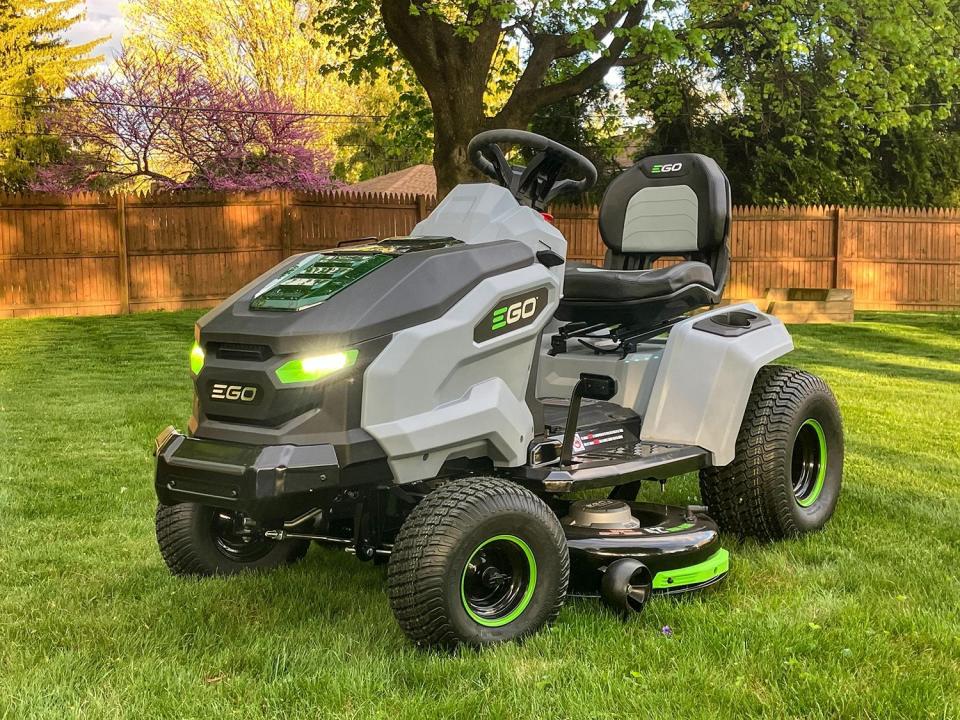
POWER+ T6
lowes.com
$3999.00
Colin AylesworthTested by Colin Aylesworth
I’m testing out Ego’s new 56-volt battery-powered lawn tractor on my roughly half-acre residential lot and have been largely pleased with the experience. The mower seems well built and has a nicely padded seat, enhancing comfort over some bumpy sections of the yard. This mower is not whisper quiet when the blades are running, but it’s far quieter than a gas-powered riding lawn mower or even a gas push-mower, at least to my ears. My neighbor has also commented on how quiet it is.
Cut quality is superb, and the T6 offers three levels of blade speed, as well as three drive speed settings. Regardless of which drive speed setting I’m in, this tractor is easy to creep along at low speeds, which is handy when I’m backing it into my shed.
Ego claims this tractor can mow up to 1.5 acres of grass on a full charge with the six included 6.0Ah batteries. In my testing, running at the middle setting for both blade and ground speed, cutting the entire yard has drained about 65- to 70-percent of the battery. This indicates to me that I’d be hard-pressed to get more than an acre of cutting on a full charge. To get more runtime, I’d likely have to slow down both the blade speed and ground speed so the lowest setting.
Charging the tractor is a simple process. The battery array is under the hood, but you don’t need to remove the batteries and charge each one individually, though you could do that. Instead, the tractor comes with a charger adapter that lets you plug the mower into a household outlet, and the batteries will charge simultaneously. It’s the same idea as charging an electric car, and could not be simpler. An LCD screen behind the steering wheel gives you a real time look at battery life as you’re cutting, as well as indicators about blade and ground speed.
Regarding maneuverability, this tractor has a decent turning radius. It isn’t as tight as you’d get with a zero-turn mower, but that’s to be expected. One nice feature of this tractor is that you can mow in reverse, which is not the case with all riding lawn mowers.
Overall, Ego’s new T6 tractor is a robust offering from a company that’s created a solid reputation for building battery-powered equipment. The T6 is not ideal if you have lots of maneuvering and turns in your yard, and your mileage may vary when it comes to real-world battery life. But beyond those issues, this tractor is fun to drive and delivers an impeccable cut.
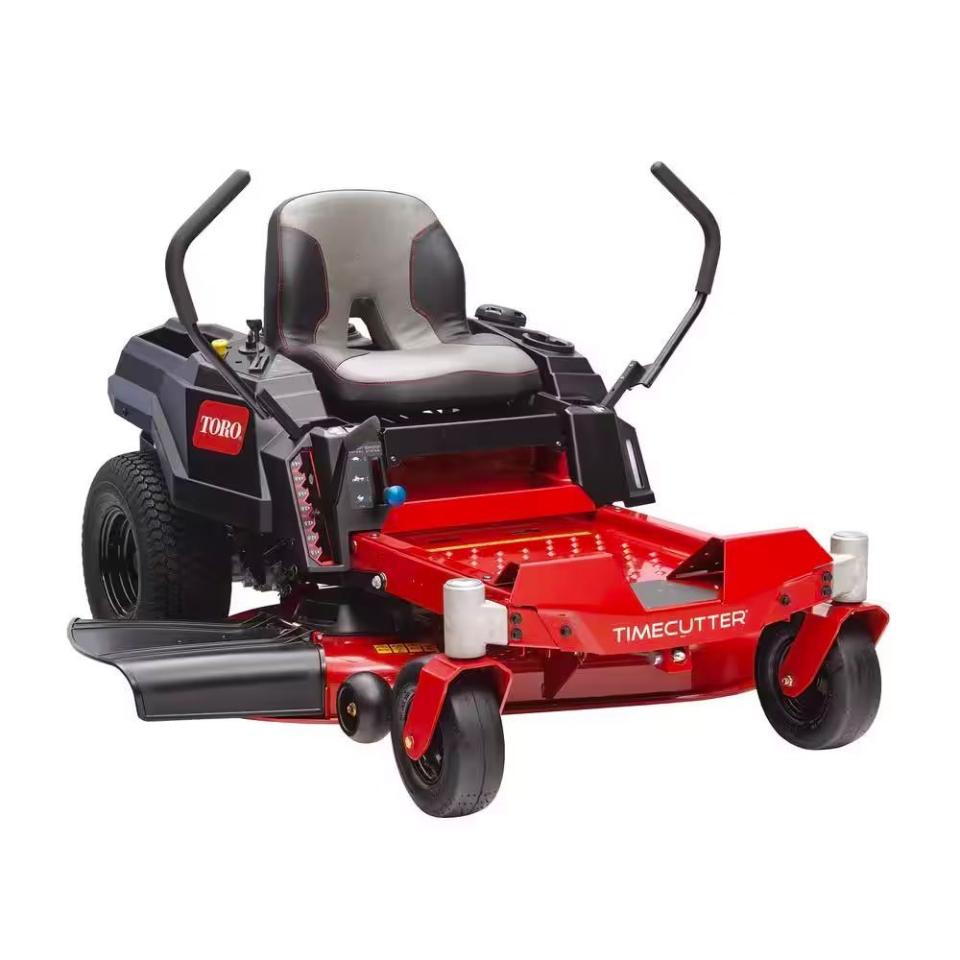
42-inch TimeCutter
lowes.com
$3299.00
You won’t find yourself spending hours mowing the yard with Toro’s aptly-named TimeCutter. Most 42-inch zero-turn mowers feature 16 to 20 horsepower engines, but the TimeCutter brings the power (and speed) with a large 22 horsepower engine. You can mow fast without having to worry about compromising cut quality.
Toro equips this mower with its proprietary Smart Speed feature, which allows you to adjust the mower’s maximum driving speed to either 4- 5.5-, or 7 mph in trim, tow and mow modes, respectively. The high range lets you zoom over long flat stretches of grass, while the slower setting gives you finesse for maneuvering around trees and flower beds. You’ll get a smooth ride at any speed thanks to Toro's MyRide suspension system.
Plus, Toro equips this mower with some attractive additional features, including a front step-through that makes it easy to get off the mower when you need to clear away errant branches or toys from the mower’s path. It also has cup holders for drinks and an under-seat cubby for storing work gloves or a pair of sunglasses.
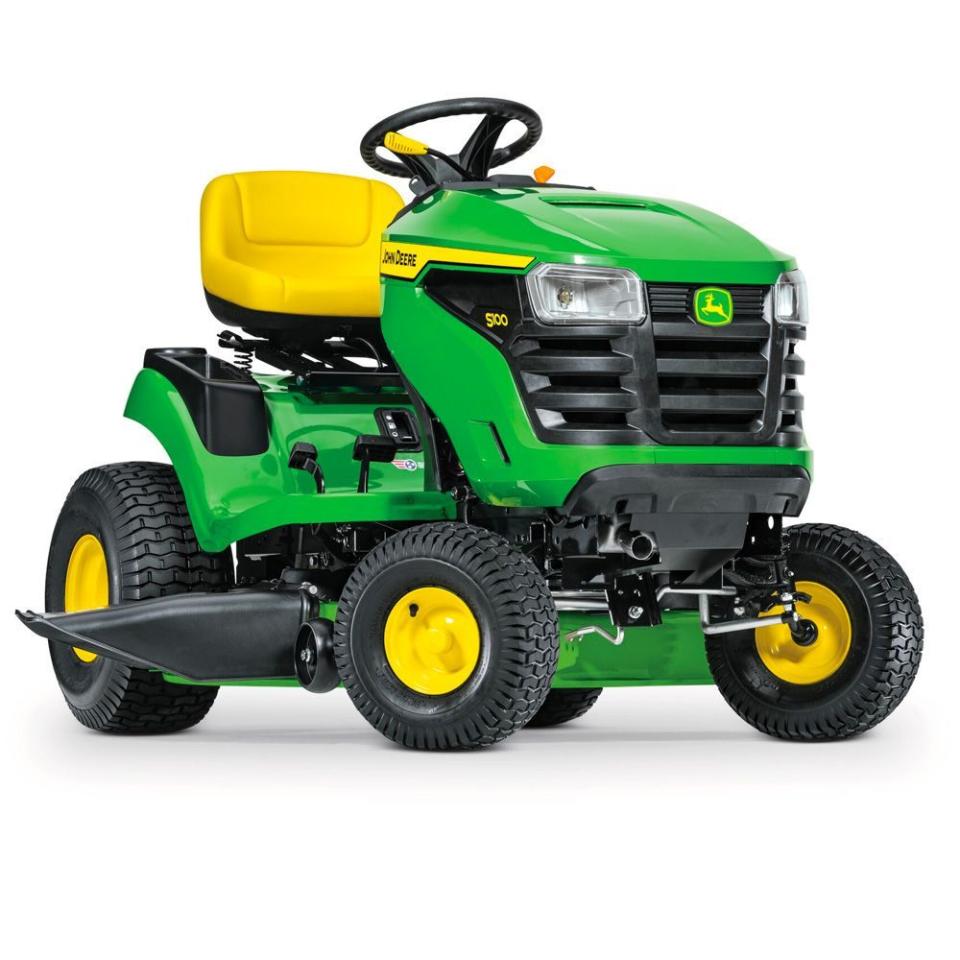
S100 Lawn Tractor
lowes.com
$2399.00
This John Deere is an affordable and durable lawn tractor with a solid cast-iron front axle and 17.5-horsepower engine to mow on any terrain. The deck has 13 height settings for a custom cut between 1- and 4-inches. Plus, there are plenty of compatible add-ons like a mulch kit, bagger, front bumper, and tow-behind spreaders and other tools.
In addition to these features, the S100 offers a reasonable 18-inch turn radius, separate gas pedals for forward and reverse, and comfort conveniences like an adjustable seat, cup holder, and small storage compartment.
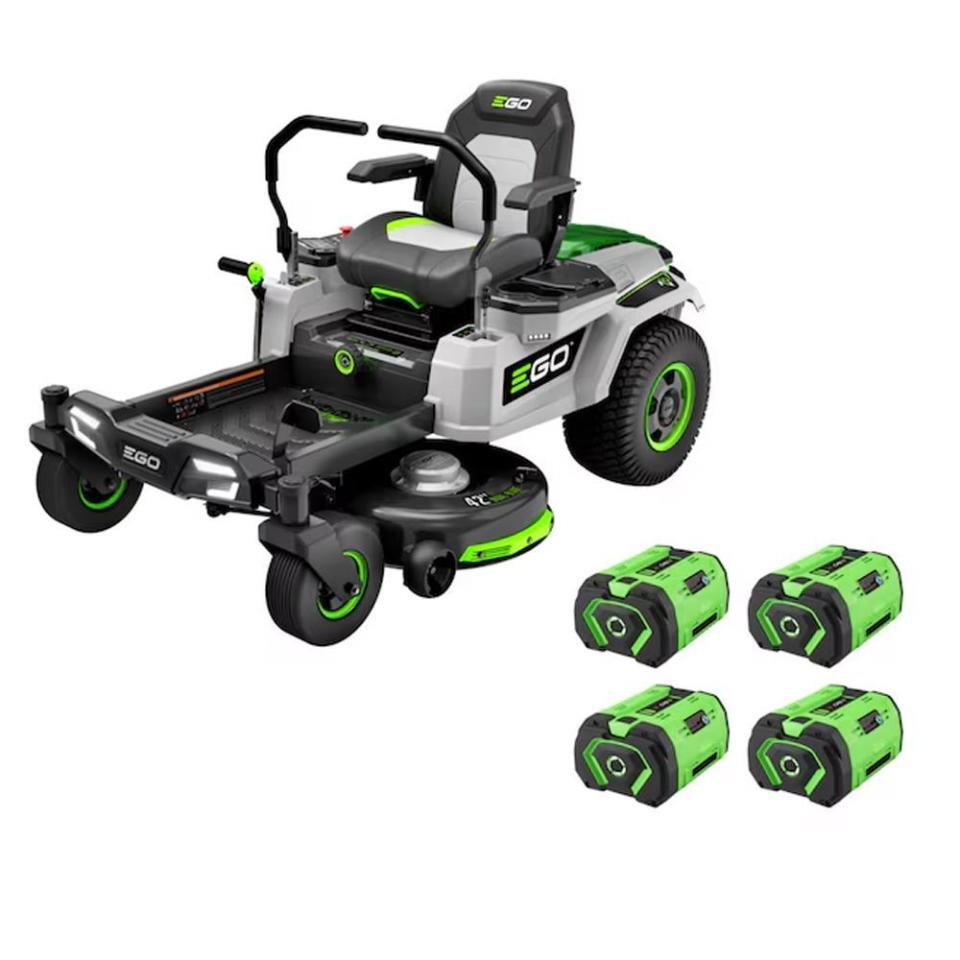
Z6 4204
amazon.com
$5499.00
Ego’s Z6 4204 is one of our picks in our Best Zero Turn mower roundup, and it has a lot going for it. It has the equivalent power to a 22 horsepower gas engine, and it delivers a great cut quality from its twin-blade, 42-inch deck.
This machine handles nicely with its two lap bars and is an ideal mower for suburban homeowners who don’t want to deal with refueling with gas or changing the oil each season.
The Z6 comes with four 10Ah batteries, and has empty slots for two additional batteries. These batteries can be used in other Ego tools, and vice versa. If you’re going out to mow a section of land and also need to do some trimming, the battery from this zero turn can run the Ego String Trimmer, for example.
The Ego Z6 has an LCD screen (similar to the one on the T6 tractor) that shows you blade speed, ground speed, and various drive modes and other information, such as battery life. If you’re interested in this mower but prefer something with a steering wheel, Ego makes such a mower. The Z6 e-steer is largely the same mower, except with an old-fashioned steering wheel rather than lap bars.
Q+A with Lawn Expert Tony Carrick
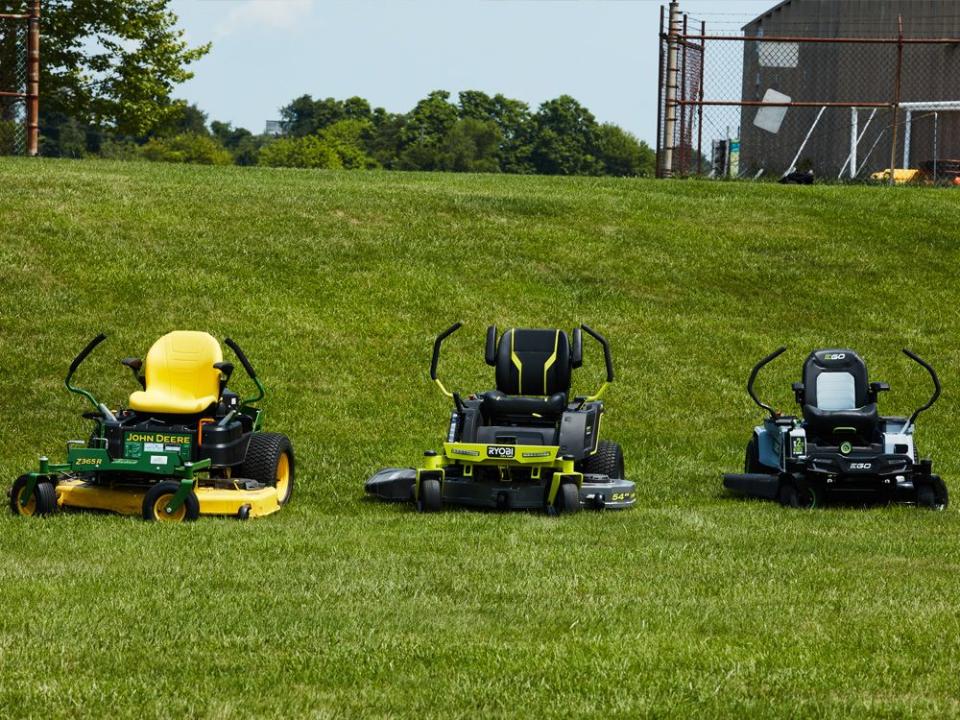
How do I know if I need a riding lawn mower?
You should start looking at riding lawn mowers if you have half an acre or more of grass to cut on your property. Riding lawn mowers cut grass using a mowing deck, which trims a wide swath of grass using one to three blades as you drive over it.
Small riding mowers usually feature a mowing deck around 30 inches wide, which means they can cut an acre in about an hour. By contrast, the average walk-behind lawn mower cuts a 21-inch swath of grass, so it would take around 2 hours to cut the same acre.
Just because they cut more grass at a time doesn’t mean they’re always better, though. It’s worth keeping in mind that riding mowers are large and somewhat unwieldy. In a smaller yard with lots of trees, gardens, and other landscaping features to avoid, you’re better off simply using a standard walk-behind mower.
How fast can a riding lawn mower go?
Your riding mower’s top speed depends on a number of factors, such as the size of the engine, which often corresponds to the size and design of the mower. Rear engine lawn mowers and lawn tractors often reach speeds ranging from 4 to 6 mph. A zero-turn lawn mower can reach faster speeds or between 7 and 10 mph.
While you’ll generally be able to get the job done more quickly with a faster mower, keep in mind that cutting with a riding lawn mower while moving at top speed may not result in a very even cut.
How long will my riding lawn mower last?
You should expect to get 10 years or more out of a good riding lawn mower. As with most machines, your specific machine’s lifespan will vary depending on how well you take care of it, though. To get the most out of it, change the oil and filter regularly, check belts and hoses for wear and tear, sharpen the blades each year, and periodically clean the mowing deck.
Also, use it regularly: Attempting to mow through thicker brush can dull the blades and strain the engine, which may lead to problems down the road.
You Might Also Like

